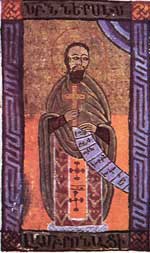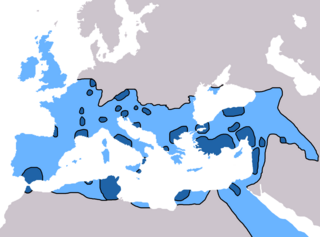
The Eastern Catholic Churches or Oriental Catholic Churches, also called the Eastern-Rite Catholic Churches, Eastern Rite Catholicism, or simply the Eastern Churches, are 23 Eastern Christian autonomous particular churches of the Catholic Church in full communion with the pope in Rome. Although they are distinct theologically, liturgically, and historically from the Latin Church, they are all in full communion with it and with each other. Eastern Catholics are a minority within the Catholic Church; of the 1.3 billion Catholics in communion with the pope, approximately 18 million are members of the eastern churches. The largest numbers of Eastern Catholics are found in Eastern Europe, Eastern Africa, the Middle East, and India. As of 2022, the Syro-Malabar Church is the largest Eastern Catholic Church, followed by the Ukrainian Greek Catholic Church.

The Armenian Apostolic Church is the autocephalous national church of Armenia. Part of Oriental Orthodoxy, it is one of the most ancient Christian institutions. The Kingdom of Armenia was the first state in history to adopt Christianity as its official religion under the rule of King Tiridates III, of the Arsacid dynasty in the early 4th century.
An apostolic see is an episcopal see whose foundation is attributed to one or more of the apostles of Jesus or to one of their close associates. In Catholicism, the phrase "The Apostolic See" when capitalized refers specifically to the See of Rome.

Isaac or Sahak of Armenia was the catholicos of the Armenian Church from c. 387 until c. 438. He is sometimes known as Isaac the Great or Sahak the Parthian in reference to his father's Parthian origin. He was the last Armenian patriarch who was directly descended from Gregory the Illuminator, who converted the Kingdom of Armenia to Christianity in the early fourth century and became the first head of the Armenian Church. He supported Mesrop Mashtots in the creation of the Armenian alphabet and personally participated in the translation of the Bible into Armenian.
A catholicos is the head of certain churches in some Eastern Christian traditions. The title implies autocephaly and, in some cases, it is the title of the head of an autonomous church. The word comes from ancient Greek καθολικός, derived from καθ' ὅλου from κατά and ὅλος, meaning "concerning the whole, universal, general"; it originally designated a financial or civil office in the Roman Empire.

Dvin was a large commercial city and the capital of early medieval Armenia. It was situated north of the previous ancient capital of Armenia, the city of Artaxata, along the banks of the Metsamor River, 35 km to the south of modern Yerevan. It is claimed it was one of the largest cities east of Constantinople prior to its destruction by the Mongols in the 13th century, but with an overall area of approximately 1 km2, it was far smaller than many of the great cities of Asia.

Nerses IV the Gracious was Catholicos of Armenia from 1166 to 1173.

Saint Nerses of Lambron (1153–1198) was the Archbishop of Tarsus in the Armenian Kingdom of Cilicia who is remembered as one of the most significant figures in Armenian literature and ecclesiastical history.
Catholicos Gevorg II of Garni was the Catholicos of the Armenian Apostolic Church between 877 and 897. His contemporary Hovhannes Draskhanakerttsi described him as a honorable man who was selected from the Catholicos's household by Prince Ashot I of Armenia to succeed Patriarch Zakaria. Gevorg anointed and crowned Ashot I when he was declared King of Armenia in 884. Upon King Ashot's death, Gevorg went to Bagaran to preside over his funeral. Ashot's heir Smbat I, who had been away at war, missed his father's funeral and was very grieved. Catholicos Gevorg went to comfort King Smbat at Yerazgavors, where he would later also preside at his coronation. This enraged the sparapet Abas who is said to have spread false rumors about the Catholicos in an attempt to bring him down. Abas tried to convince a holy man named Mashtots from Sevanavank to join his conspiracy against the Catholicos and said he would name him Catholicos if it was successful. Mashtots wrote a long letter in response, rejecting the offer to rebel against the Catholicos and chided Abas for his attempt. Hovhannes Draskhanakerttsi reports at this point Abas was struck by an illness and died, as if by divine wrath, and the other conspirators repented to the Catholicos out of fear. Around this time Dvin was hit by an earthquake, as it had been during Patriarch Zakaria's time, but this time it destroyed the church of the Catholicosate, as well as many other buildings and people.

In the history of Christianity, the first seven ecumenical councils include the following: the First Council of Nicaea in 325, the First Council of Constantinople in 381, the Council of Ephesus in 431, the Council of Chalcedon in 451, the Second Council of Constantinople in 553, the Third Council of Constantinople from 680 to 681 and finally, the Second Council of Nicaea in 787. All of the seven councils were convened in what is now the country of Turkey.

Zvartnots Cathedral is a medieval Armenian cathedral near Vagharshapat (Ejmiatsin), Armenia. Built in the seventh century and now lying in ruins, Zvartnots was noted for its circular exterior structure, unique in medieval Armenian architecture, and a set of interior piers that upheld a multifloor structure crowned with a dome.
The Church of Albania or the Albanian Apostolic Church was an ancient, briefly autocephalous church established in the 5th century. In 705, it fell under the religious jurisdiction of the Armenian Apostolic Church as the Catholicosate of Aghvank centered in Caucasian Albania, a region spanning present-day northern Azerbaijan and southern Dagestan.

In the 5th century in Christianity, there were many developments which led to further fracturing of the State church of the Roman Empire. Emperor Theodosius II called two synods in Ephesus, one in 431 and one in 449, that addressed the teachings of Patriarch of Constantinople Nestorius and similar teachings. Nestorius had taught that Christ's divine and human nature were distinct persons, and hence Mary was the mother of Christ but not the mother of God. The Council rejected Nestorius' view causing many churches, centered on the School of Edessa, to a Nestorian break with the imperial church. Persecuted within the Roman Empire, many Nestorians fled to Persia and joined the Sassanid Church thereby making it a center of Nestorianism. By the end of the 5th century, the global Christian population was estimated at 10-11 million. In 451 the Council of Chalcedon was held to clarify the issue further. The council ultimately stated that Christ's divine and human nature were separate but both part of a single entity, a viewpoint rejected by many churches who called themselves miaphysites. The resulting schism created a communion of churches, including the Armenian, Syrian, and Egyptian churches, that is today known as Oriental Orthodoxy. In spite of these schisms, however, the imperial church still came to represent the majority of Christians within the Roman Empire.

Christianity in late antiquity traces Christianity during the Christian Roman Empire — the period from the rise of Christianity under Emperor Constantine, until the fall of the Western Roman Empire. The end-date of this period varies because the transition to the sub-Roman period occurred gradually and at different times in different areas. One may generally date late ancient Christianity as lasting to the late 6th century and the re-conquests under Justinian of the Byzantine Empire, though a more traditional end-date is 476, the year in which Odoacer deposed Romulus Augustus, traditionally considered the last western emperor.

Komitas I Aghtsetsi or Komitas I of Aghdznik was a Catholicos of Armenia and Supreme Patriarch as well as the bishop of Taron from 615 until his death in 628. He is known also as Komitas Shinogh, "The Builder" — an allusion to his significant patronage of building and restoration work He was instrumental in the realization of several architectural projects, among which were the complete renovation of the Cathedral at the Holy See of Etchmiadzin; the construction of the Church of St. Hripsime, which stands to this day on the site of an earlier edifice; and the building of the Church of St. Gregory in Dvin.
The First Council of Dvin was a church council held in 506 in the city of Dvin. It convened to discuss the Henotikon, a christological document issued by Byzantine emperor Zeno in an attempt to resolve theological disputes that had arisen from the Council of Chalcedon.
The Third Council of Dvin was a church council held in 607 in the city of Dvin.
The Second Council of Dvin was a church Synod or ecumenical Council held in 554 in the city of Dvin.
The Council of Thedosioupolis was a church synod held at Erzurum, in Armenia between February 631 and February 632 AD.
The Council of Partav was a church synod held in about 703 in Caucasian Albania. The Council condemned the Georgian Church's adherence to the decision of the Council of Chalcedon. and was an important step in the schism between the Armenian Church and the Byzantine and Georgian Churches.










